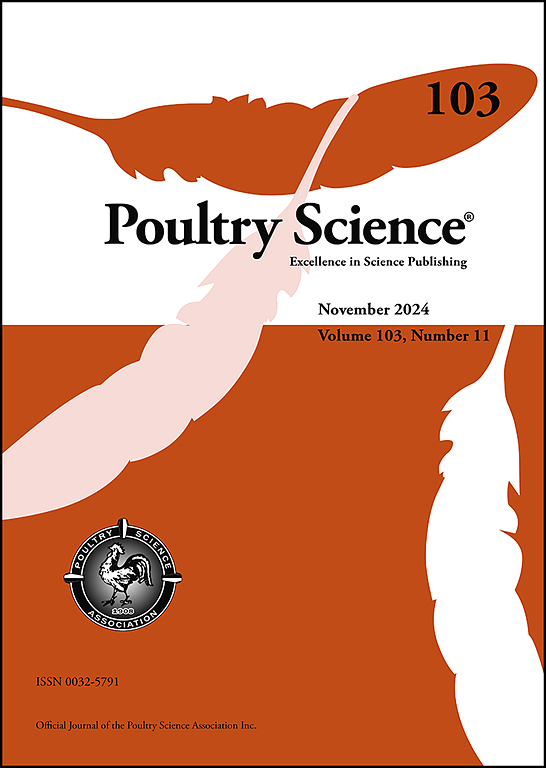Research note: High levels of lead and arsenic in imported dried black soldier fly larvae: implications for backyard poultry supplementation
IF 3.8
1区 农林科学
Q1 AGRICULTURE, DAIRY & ANIMAL SCIENCE
引用次数: 0
Abstract
Insects provide essential nutrition to poultry, however, the feedstock fed to the insects and the age and method of processing, can significantly impact nutrient and safety levels. The purpose of this research was to examine the nutrient and safety of black solider fly larvae (BSFL). Over a two-year period, 21 BSFL were purchased from retail and online establishments and blindly labeled and sent to accredited laboratories for proximate analysis, heavy metal analysis and antibiotic residues. No samples contained detectable levels of antibiotic residues. On average, Chinese-sourced dried black solider fly larvae (DBSFL), had 25X more lead and 8X more arsenic than North American, both values were statistically different. Chinese-sourced DBSFL had significantly lower phosphorus, protein, magnesium, potassium and manganese as compared to those from North America (p<0.05). While North American DBSFL had significantly lower fat and iron levels than Chinese-sourced DBSFL. Many of the imported products did not have or were not compliant with current US regulatory labeling requirements. The mislabeling and higher levels of heavy metals in DBSFL is concerning as it not only can affect the health of back yard flocks and humans via consumption of eggs from backyard flocks but also has the potential to contaminate the environment. Keywords: Dried black solider fly larva; Heavy Metal; Layer; Backyard chicken
研究说明:进口干黑虻幼虫中铅和砷含量高:对后院家禽补充的影响
昆虫为家禽提供必需的营养,然而,饲喂昆虫的原料、年龄和加工方法会对营养和安全水平产生重大影响。本研究旨在探讨黑虻幼虫(BSFL)的营养和安全性。在两年多的时间里,从零售和网上机构购买了21个BSFL,并盲目标记并送到认可的实验室进行近似分析,重金属分析和抗生素残留。没有样品含有可检测到的抗生素残留。中国产干黑虻幼虫(DBSFL)的平均铅含量比北美产高25倍,砷含量高8倍,两者差异有统计学意义。中国产DBSFL的磷、蛋白质、镁、钾和锰含量显著低于北美产(p < 0.05)。而北美DBSFL的脂肪和铁含量明显低于中国来源的DBSFL。许多进口产品没有或不符合当前美国监管标签要求。DBSFL中标签错误和重金属含量较高的问题令人担忧,因为它不仅会通过食用后院鸡群的鸡蛋影响后院鸡群和人类的健康,而且还可能污染环境。关键词:干黑虻幼虫;重金属;层;后院的鸡
本文章由计算机程序翻译,如有差异,请以英文原文为准。
求助全文
约1分钟内获得全文
求助全文
来源期刊

Poultry Science
农林科学-奶制品与动物科学
CiteScore
7.60
自引率
15.90%
发文量
0
审稿时长
94 days
期刊介绍:
First self-published in 1921, Poultry Science is an internationally renowned monthly journal, known as the authoritative source for a broad range of poultry information and high-caliber research. The journal plays a pivotal role in the dissemination of preeminent poultry-related knowledge across all disciplines. As of January 2020, Poultry Science will become an Open Access journal with no subscription charges, meaning authors who publish here can make their research immediately, permanently, and freely accessible worldwide while retaining copyright to their work. Papers submitted for publication after October 1, 2019 will be published as Open Access papers.
An international journal, Poultry Science publishes original papers, research notes, symposium papers, and reviews of basic science as applied to poultry. This authoritative source of poultry information is consistently ranked by ISI Impact Factor as one of the top 10 agriculture, dairy and animal science journals to deliver high-caliber research. Currently it is the highest-ranked (by Impact Factor and Eigenfactor) journal dedicated to publishing poultry research. Subject areas include breeding, genetics, education, production, management, environment, health, behavior, welfare, immunology, molecular biology, metabolism, nutrition, physiology, reproduction, processing, and products.
 求助内容:
求助内容: 应助结果提醒方式:
应助结果提醒方式:


